BN- Nothing feels quite like finding the perfect bike. As the weather continues to warm up (in between these nasty storms), more people are...
BN- Nothing feels quite like finding the perfect bike. As the weather continues to warm up (in between these nasty storms), more people are choosing to ride a motorcycle for the first time. This is great, but when you’re a new rider, there’s a lot of information to take in. In order to help keep you, and everybody else on the road who you're riding around, we’ve compiled a list of the basic things you need to keep in mind before you twist the throttle for the first time. Above all, we hope you’ll do two things for many years after your first time: have fun, and ride safe. Read on for Everything First-Time Motorcycle Riders Need to Know.
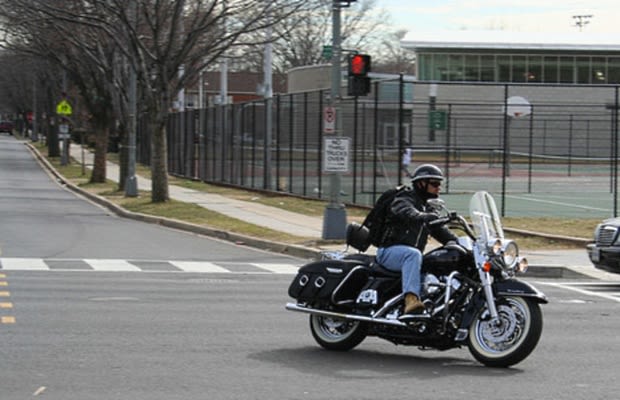
Target fixation is a major problem when you first start riding. The single most important thing you can learn about piloting that bike is this: you'll go wherever you're looking. So if you're looking at the ground up ahead, that's where you're going to go. Look far into the distance and observe what's going on around you, and you'll keep going that way.
This is an especially important thing to think about when you're approaching corners. Look through the corner, not down at the ground somewhere in the middle. Is there a median separating the two directions of traffic? Are there potholes? Any other road hazards to avoid, such as pieces of someone's junker that have fallen off in the road? Small animals, children, or other pedestrians? A huge part of riding is just looking ahead and anticipating what you'll do in any given situation. Play "what if?" games with yourself often and you'll keep the shiny side up to ride another day.
In addition, you can use turning your head as another signal to drivers around you that you're going to be moving or turning. Anything that will make other people see or pay attention to you is a good thing, even it's just as subtle as turning your helmet to the left.
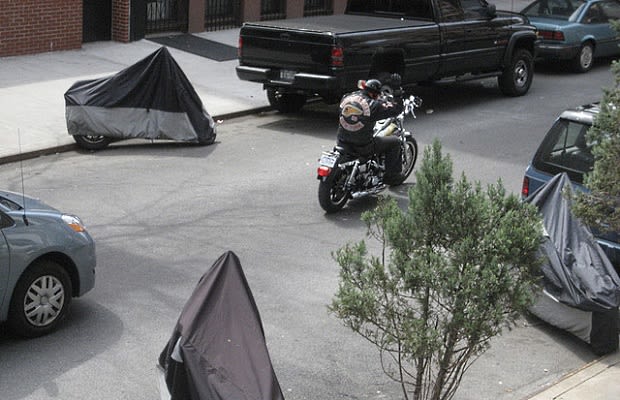 This might sound slightly over the top (it's really not at all), but when you ride on the street, you need to pretend everything and everyone is out to hit you. A lot of people aren't looking for motorcycles on the road. They'll see your car, but they might not necessarily see your bike, even if it's flaming metallic orange. We've all been irritated by those assholes who text or otherwise aren't paying attention. Keep in mind that what's irritating and possibly damaging to your car could total your bike, as well as seriously injure or kill you. The stakes are much higher when you ride. We're not trying to scare you off. You just need to accept that fact and do what you can to lessen your risk so you can keep riding long into the future.
This might sound slightly over the top (it's really not at all), but when you ride on the street, you need to pretend everything and everyone is out to hit you. A lot of people aren't looking for motorcycles on the road. They'll see your car, but they might not necessarily see your bike, even if it's flaming metallic orange. We've all been irritated by those assholes who text or otherwise aren't paying attention. Keep in mind that what's irritating and possibly damaging to your car could total your bike, as well as seriously injure or kill you. The stakes are much higher when you ride. We're not trying to scare you off. You just need to accept that fact and do what you can to lessen your risk so you can keep riding long into the future.
You can't do anything about other people on the road, except maybe tell everyone you know to pay more attention to motorcycles when they're driving. What you can control is how you ride. Pay absolute attention before and at every single intersection. We're not just talking street corners. We also mean alleys, parking lots, drive-thrus, gas stations, anywhere a vehicle is going to try to enter moving traffic from a stand-still. Scan ahead with your eyes to note any possible traffic dangers in your way. Is there a lane merge up ahead? Construction? A utility truck doing some work? An accident? Does a cop have someone pulled over? All these possibilities may lead to someone who wasn't paying attention suddenly deciding that they have to merge into your lane RIGHTNOWRIGHTNOWRIGHTNOW without looking first. Just a second's inattention can mean someone sideswipes you because they didn't see you. By anticipating potentially dangerous situations up ahead, you'll be ready to move out of the way or brake as necessary.
Also, don't draft semis and don't ride in anyone's blind spot. Ride up ahead of them or far enough behind that if they suddenly switch lanes without signalling, you won't get hit. These are good rules of thumb to prevent being sideswiped. If you can see yourself in someone's mirror, they can most likely see you. (You know, as long as they're actually using their mirrors.)
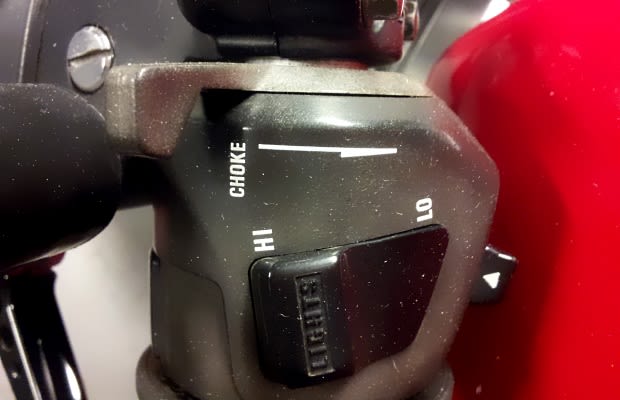 Also, don't panic if you forget to turn it off once or twice. Most new bike owners will do it at least once. You know you need to turn it on to prime the engine after it's been sitting cold for any length of time, but turning it off isn't second nature yet. If you leave it on, you'll be running your bike rich unnecessarily for however long you leave it on past the initial warmup. Over time, this could cause problems -- but more immediately, you'll just be wasting gas. With prices hovering around $4 (and more) per gallon these days, why on earth would you want to waste gas?
Also, don't panic if you forget to turn it off once or twice. Most new bike owners will do it at least once. You know you need to turn it on to prime the engine after it's been sitting cold for any length of time, but turning it off isn't second nature yet. If you leave it on, you'll be running your bike rich unnecessarily for however long you leave it on past the initial warmup. Over time, this could cause problems -- but more immediately, you'll just be wasting gas. With prices hovering around $4 (and more) per gallon these days, why on earth would you want to waste gas?
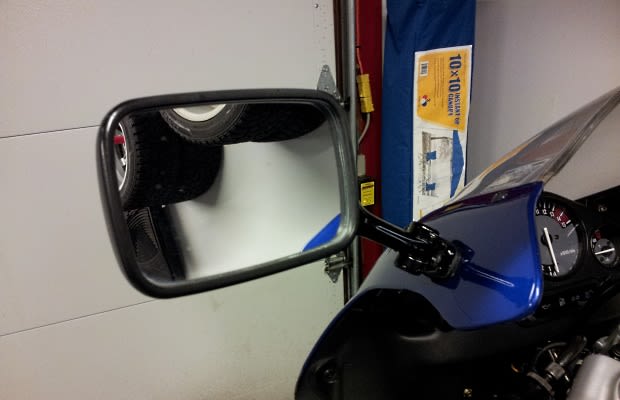 Unlike a car, it's not always possible to adjust motorcycle mirrors without a wrench. That's why you want to check their positioning before you start riding. It's simple. Just get on the bike in riding position and check that the mirrors are where you need them to be able to see as much as you can around you. If your bike has a center stand, this is especially easy to do while it's sitting on the center stand. If not, get on the bike and point it straight ahead. Hold the front brake lever if you're on a downhill incline. Adjust as necessary.
Unlike a car, it's not always possible to adjust motorcycle mirrors without a wrench. That's why you want to check their positioning before you start riding. It's simple. Just get on the bike in riding position and check that the mirrors are where you need them to be able to see as much as you can around you. If your bike has a center stand, this is especially easy to do while it's sitting on the center stand. If not, get on the bike and point it straight ahead. Hold the front brake lever if you're on a downhill incline. Adjust as necessary.
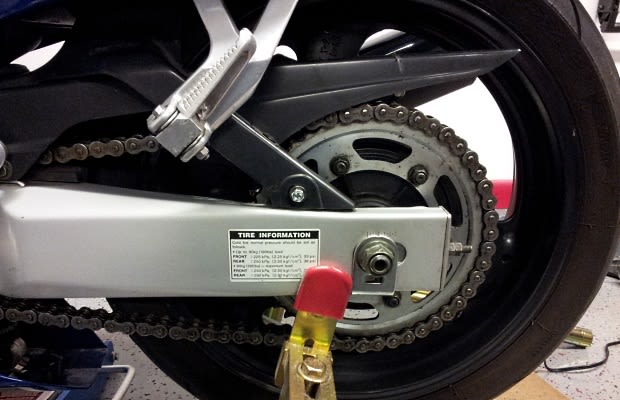 Motorcycles are powered one of three ways: chain-driven, belt-driven, or shaft-driven. Shaft- and belt-driven bikes require less frequent maintenance than chain-driven ones. Most cruisers are belt-driven, while most sport bikes are chain-driven. BMW isn't the only company that makes shaft-driven bikes, but they're the most common bikes on which you'll find the system.
Motorcycles are powered one of three ways: chain-driven, belt-driven, or shaft-driven. Shaft- and belt-driven bikes require less frequent maintenance than chain-driven ones. Most cruisers are belt-driven, while most sport bikes are chain-driven. BMW isn't the only company that makes shaft-driven bikes, but they're the most common bikes on which you'll find the system.
Why does this matter? When you're riding a bike, that chain or belt or shaft is what keeps your bike moving. There isn't a lot to examine on a shaft-driven bike (if it's broken, you'll know it), but you should check your chain or belt before you head out. If that chain or belt is in bad condition, or is improperly adjusted, it can break. At the least, that means you're walking home. At the most, it can cause you to have an accident.
To inspect a chain, turn the rear wheel and watch the chain move. Does it move freely? Do any of the links looked cracked or worn? Is it really, really dirty? Does it seem really loose or really tight? A chain in good condition should move freely and should not be super loose or super tight. (Proper chain adjustment is its own topic) Chains get dirty as you ride, but it shouldn't be so dirty that the grime is preventing smooth movement. If a chain gets too dirty, it can get stiff and not move smoothly like it should. That's why proper bike maintenance of chain driven bikes includes cleaning and waxing your chain regularly. If that chain has broken or missing links, don't ride it until you replace the chain. It's not safe.
To inspect a belt, turn the rear wheel and watch the belt move. Does it move smoothly? Does it have any weird cracks or tears, or does it look like it's been chewed at the edges, or along any of the teeth? If it has any cracks, tears, or jagged edges like it's been chewed, it's due for replacement. You probably shouldn't ride it until it's replaced.
Finally, check for any oil or other fluids leaking anywhere on the bike. Look at the front forks as well, because they have fluid inside. If the seals on the forks need to be replaced, you may see some fluid seeping out. If anything is leaking, get your bike checked out by someone who knows what they're doing.
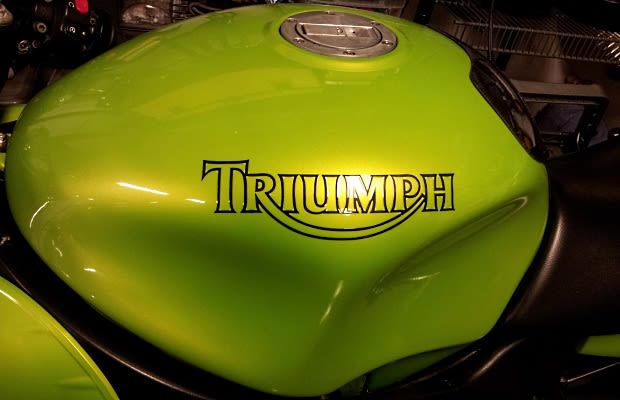 Some bikes have fuel gauges. Others don't. It's not a new bike vs. old bike thing, either; it's often just a style decision by the manufacturer, regardless of the age or type of your bike. If you know your bike's estimated MPG and its fuel capacity, you can set a trip odometer on the bike to tell you when you need to start looking for a gas station. If you're out riding some fun, twisty back roads in the middle of nowhere, this makes a huge difference. If you're only going to be riding in the city, this doesn't matter as much.
Some bikes have fuel gauges. Others don't. It's not a new bike vs. old bike thing, either; it's often just a style decision by the manufacturer, regardless of the age or type of your bike. If you know your bike's estimated MPG and its fuel capacity, you can set a trip odometer on the bike to tell you when you need to start looking for a gas station. If you're out riding some fun, twisty back roads in the middle of nowhere, this makes a huge difference. If you're only going to be riding in the city, this doesn't matter as much.
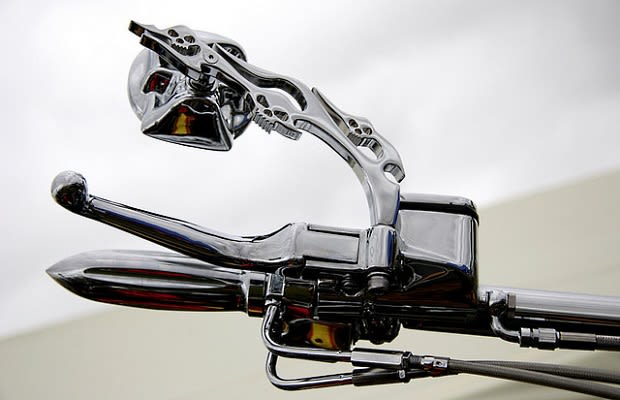 It might look good, but chrome gets hot in the sun. Keep that in mind, if you're riding anything with chrome grips, since your hands will be on those the entire time you're riding. We recommend wearing armored gloves when you're riding, anyway. They'll keep your hands from getting hot (especially if you get summer gloves, which are perforated to provide good airflow), and they'll protect you exponentially better than bare skin in a crash. Considering you need your hands to do pretty much everything, you definitely want to protect them. What's the first thing most people do when they fall? Reach out their hands to stop themselves. Phalange protection is just smart.
It might look good, but chrome gets hot in the sun. Keep that in mind, if you're riding anything with chrome grips, since your hands will be on those the entire time you're riding. We recommend wearing armored gloves when you're riding, anyway. They'll keep your hands from getting hot (especially if you get summer gloves, which are perforated to provide good airflow), and they'll protect you exponentially better than bare skin in a crash. Considering you need your hands to do pretty much everything, you definitely want to protect them. What's the first thing most people do when they fall? Reach out their hands to stop themselves. Phalange protection is just smart.
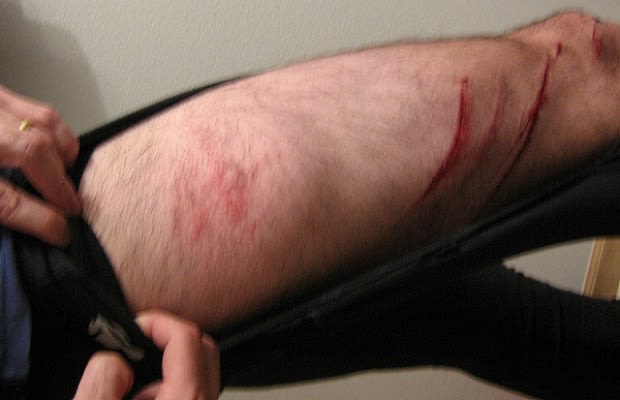 You never want to think about going down. Sad fact is, even if it's just a minor tip-over, most riders will go down at some point in their riding career. (We know a lot of riders, and only one of them has ridden for years and never been down. Seriously.) You're more likely to go down when you're just starting out, since you don't know how to handle the bike yet.
You never want to think about going down. Sad fact is, even if it's just a minor tip-over, most riders will go down at some point in their riding career. (We know a lot of riders, and only one of them has ridden for years and never been down. Seriously.) You're more likely to go down when you're just starting out, since you don't know how to handle the bike yet.
There's a huge amount of armored gear to choose from to protect yourself if and when you do fall. Jeans will shred if you have a nasty fall, and you'll get some terrible (and painful) road rash. Some companies offer Kevlar-reinforced jeans, which are slightly better, but armored pants are better still because they'll protect your knees and hips. (Trust us, it's no fun to not be able to walk for any period of time because you were stupid.) If you're into motorcycle racing, you already know some of this stuff can look pretty cool, too. Both leather and textile protective gear is available in a wide variety of sizes and styles to suit your personal look.
 It's a hot day. You can't wait to go for a ride. Even though it's hot, wear a couple of layers (or pack some layers in a backpack or in your bike's luggage, if it has it). If you're riding a long distance, or if you're going to be out for a long period of time, chances are good the temperature will change. You'll feel it more than anyone else when you're out on two wheels, even if you're riding a fully faired bike with a big windscreen. On average, going highway speeds makes you feel like the temperature is 10 degrees less than your local weather forecast says it is. Keep that in mind.
It's a hot day. You can't wait to go for a ride. Even though it's hot, wear a couple of layers (or pack some layers in a backpack or in your bike's luggage, if it has it). If you're riding a long distance, or if you're going to be out for a long period of time, chances are good the temperature will change. You'll feel it more than anyone else when you're out on two wheels, even if you're riding a fully faired bike with a big windscreen. On average, going highway speeds makes you feel like the temperature is 10 degrees less than your local weather forecast says it is. Keep that in mind.
Also, most motorcycle gear manufacturers make full mesh jackets for riding in the hottest weather. These have armor in them to protect you if you fall, but allow massive airflow to keep you cool. Staying covered when it's hot helps keep you from dehydrating or getting sunburned, too. What do you have to lose?
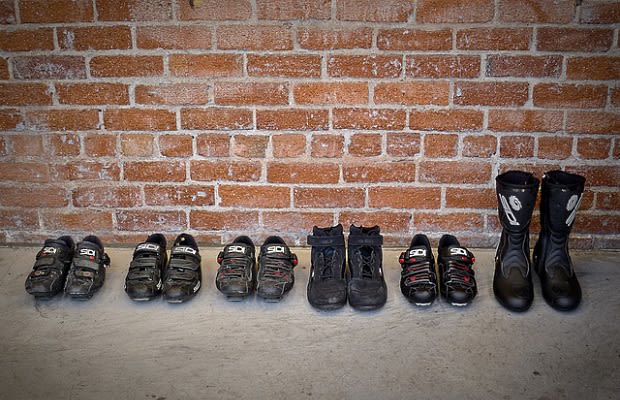
Roads get slippery for a number of reasons. Rain and snow are obvious ones, but sometimes oil and other automotive fluids drip out all over the road. Steer your bike around any weird puddles you see on the road if you can, but sometimes stuff just coats the surface of the road and makes it slippery and there's no way to avoid it.
When you put your feet down at a stop, you want to be sure that whatever shoes you're wearing will grip the road securely, not slip and slide and make you feel like you're going to drop the bike. That's another reason why we recommend motorcycle-specific boots, but any good non-slip shoe is better than a slippery-bottomed (but sick-looking) sneaker. Before you get mad, keep in mind that not all shoes have equal grip on all surfaces. Some shoes might be perfect for a polished wood gym floor, but suck at slick asphalt. Shoe makers make different sneakers to suit different athletic pursuits, so this isn't exactly a surprise.
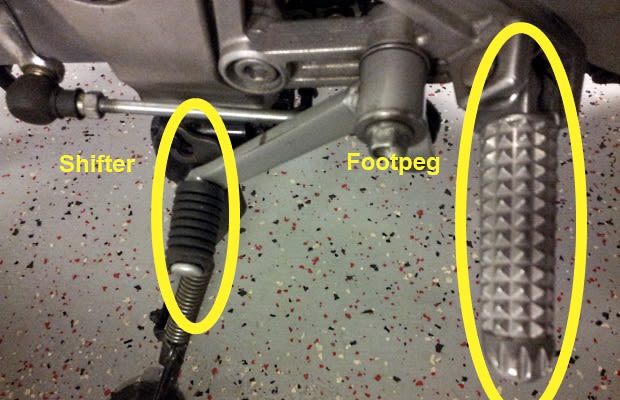 Although we strongly suggest riding with a good pair of over-the-ankle motorcycle boots (they help prevent your ankle from being broken or twisted in accidents, which is nice), you might want to go out wearing something else on your feet. Unless your bike has a heel-toe shifter (a big floorboard-looking thing that you upshift by pushing the front down with your toes and downshift by pushing the back down with your heel), you're going to scuff up whatever shoes you wear. Many motorcycle-specific boots have shifter pads on them that take all the damage, so the rest of your boot stays nice and scuff-free.
Although we strongly suggest riding with a good pair of over-the-ankle motorcycle boots (they help prevent your ankle from being broken or twisted in accidents, which is nice), you might want to go out wearing something else on your feet. Unless your bike has a heel-toe shifter (a big floorboard-looking thing that you upshift by pushing the front down with your toes and downshift by pushing the back down with your heel), you're going to scuff up whatever shoes you wear. Many motorcycle-specific boots have shifter pads on them that take all the damage, so the rest of your boot stays nice and scuff-free.
This is also one of the many reasons it's a bad idea to wear flip-flops or other sandals while riding a bike. Safety issues aside, it's going to hurt your foot every single time you shift. Who wants that? If you're going to wear normal shoes, wear shoes you don't care about scuffing or you're going to have a sad when you're done with your first ride.
 Different states have different requirements of motorcyclists. Many states require you to wear a DOT-certified helmet while riding a motorcycle, including New York. Some states have rules that say only riders aged 17 and under must wear a helmet, while others require no helmet at all, such as Illinois. For the most current helmet information regarding any state in which you'll be riding, check the Insurance Institute for Highway Safety's page on the subject.
Different states have different requirements of motorcyclists. Many states require you to wear a DOT-certified helmet while riding a motorcycle, including New York. Some states have rules that say only riders aged 17 and under must wear a helmet, while others require no helmet at all, such as Illinois. For the most current helmet information regarding any state in which you'll be riding, check the Insurance Institute for Highway Safety's page on the subject.
Helmets aren't the only thing you need to be concerned about. Even states that don't require helmets might have other requirements instead. For example, Illinois requires you to wear some type of eye protection if you choose to wear no helmet (this means that sunglasses are legally acceptable). States may also have different rules about whether mirrors are required on your bike. You can't go wrong if your low beam, high beam, and turn signals are all working, and if you have both a right and a left mirror on your bike. (Note: Some states only require you to have one mirror.)
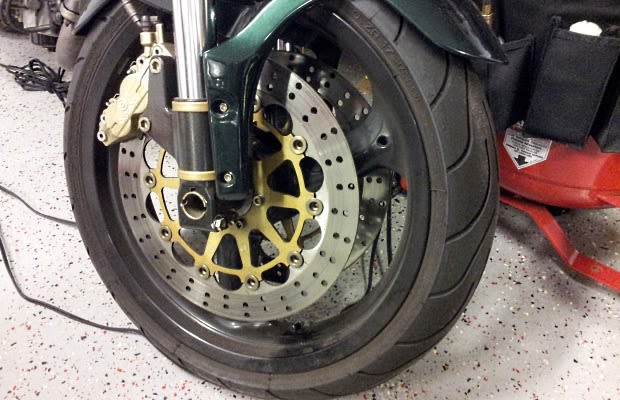
Since you're rolling on two wheels, you need to be especially careful about slow leaks, nails, screws, glass, or anything else that might be stuck in one of your tires. Do a thorough visual check to be sure your tires look like they're in good condition, with no cuts or nicks or foreign materials lodged in them. Even sharp rocks can cause serious tire damage.
Spin the wheels around so you can see the tire from all angles. It may seem like a small thing, but you're trusting your life to your rubber. A sudden tire blowout on a car is inconvenient. A sudden tire blowout on a bike can result in serious injury or death, especially if it's your first time out and you haven't gotten used to riding yet. Take a couple minutes to check, and there shouldn't be any reason you can't have an awesome time getting to know your bike.
 You might not pay much attention to tire pressure on your car. Although you should check it on your car regularly, it matters a whole lot more when you're rolling on only two wheels instead of four. Proper tire pressure means you'll get the best handling performance out of your bike. Low tire pressure can make your bike incredibly difficult and dangerous to control.
You might not pay much attention to tire pressure on your car. Although you should check it on your car regularly, it matters a whole lot more when you're rolling on only two wheels instead of four. Proper tire pressure means you'll get the best handling performance out of your bike. Low tire pressure can make your bike incredibly difficult and dangerous to control.
Somewhere on your bike, you'll find a metal plaque with your bike's VIN and a bunch of other information, including the proper PSI ratings for your front and rear tires. Use a good tire gauge (ideally one with an analog face, not one of those little metal ones you can find in the dollar bin at any auto parts store; the latter are unreliable) to check your pressure. Then be prepared to add more air if necessary. Don't forget to put your valve stem caps back on before you head out.
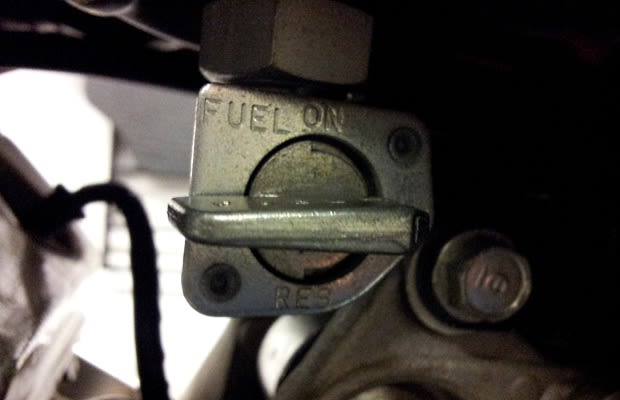 If your bike is carbureted rather than fuel-injected, chances are excellent that you'll have a fuel petcock valve with three positions: ON, OFF, and RES. You'll already be familiar with this if you've taken any MSF beginner rider courses, as well as most similar courses from other riding schools.
If your bike is carbureted rather than fuel-injected, chances are excellent that you'll have a fuel petcock valve with three positions: ON, OFF, and RES. You'll already be familiar with this if you've taken any MSF beginner rider courses, as well as most similar courses from other riding schools.
This valve controls the fuel flow from your gas tank to your engine. If it's not turned on, your engine won't be getting any fuel. As you ride along and your fuel level gets close to empty, the bike will start to hiccup. It's important to know exactly where your fuel valve is and where all three positions are so you can reach down and switch it to RES, short for "Reserve," before the bike shudders to a halt. Ideally, you want to be able to do this without looking, so you don't have to take your eyes off the road. When you do get down this low, you need to find a gas station ASAP. Don't forget to turn the valve back to ON before you ride away from the pump.
Look where you want to go.

Photo by Elvert Barnes on Flickr
Target fixation is a major problem when you first start riding. The single most important thing you can learn about piloting that bike is this: you'll go wherever you're looking. So if you're looking at the ground up ahead, that's where you're going to go. Look far into the distance and observe what's going on around you, and you'll keep going that way.
This is an especially important thing to think about when you're approaching corners. Look through the corner, not down at the ground somewhere in the middle. Is there a median separating the two directions of traffic? Are there potholes? Any other road hazards to avoid, such as pieces of someone's junker that have fallen off in the road? Small animals, children, or other pedestrians? A huge part of riding is just looking ahead and anticipating what you'll do in any given situation. Play "what if?" games with yourself often and you'll keep the shiny side up to ride another day.
In addition, you can use turning your head as another signal to drivers around you that you're going to be moving or turning. Anything that will make other people see or pay attention to you is a good thing, even it's just as subtle as turning your helmet to the left.
Ride more defensively than you drive.

Photo by SliceofNYC on Flickr
You can't do anything about other people on the road, except maybe tell everyone you know to pay more attention to motorcycles when they're driving. What you can control is how you ride. Pay absolute attention before and at every single intersection. We're not just talking street corners. We also mean alleys, parking lots, drive-thrus, gas stations, anywhere a vehicle is going to try to enter moving traffic from a stand-still. Scan ahead with your eyes to note any possible traffic dangers in your way. Is there a lane merge up ahead? Construction? A utility truck doing some work? An accident? Does a cop have someone pulled over? All these possibilities may lead to someone who wasn't paying attention suddenly deciding that they have to merge into your lane RIGHTNOWRIGHTNOWRIGHTNOW without looking first. Just a second's inattention can mean someone sideswipes you because they didn't see you. By anticipating potentially dangerous situations up ahead, you'll be ready to move out of the way or brake as necessary.
Also, don't draft semis and don't ride in anyone's blind spot. Ride up ahead of them or far enough behind that if they suddenly switch lanes without signalling, you won't get hit. These are good rules of thumb to prevent being sideswiped. If you can see yourself in someone's mirror, they can most likely see you. (You know, as long as they're actually using their mirrors.)
Don't forget to turn your choke off.

Adjust your mirrors before you start moving.

Do a pre-ride inspection.

Why does this matter? When you're riding a bike, that chain or belt or shaft is what keeps your bike moving. There isn't a lot to examine on a shaft-driven bike (if it's broken, you'll know it), but you should check your chain or belt before you head out. If that chain or belt is in bad condition, or is improperly adjusted, it can break. At the least, that means you're walking home. At the most, it can cause you to have an accident.
To inspect a chain, turn the rear wheel and watch the chain move. Does it move freely? Do any of the links looked cracked or worn? Is it really, really dirty? Does it seem really loose or really tight? A chain in good condition should move freely and should not be super loose or super tight. (Proper chain adjustment is its own topic) Chains get dirty as you ride, but it shouldn't be so dirty that the grime is preventing smooth movement. If a chain gets too dirty, it can get stiff and not move smoothly like it should. That's why proper bike maintenance of chain driven bikes includes cleaning and waxing your chain regularly. If that chain has broken or missing links, don't ride it until you replace the chain. It's not safe.
To inspect a belt, turn the rear wheel and watch the belt move. Does it move smoothly? Does it have any weird cracks or tears, or does it look like it's been chewed at the edges, or along any of the teeth? If it has any cracks, tears, or jagged edges like it's been chewed, it's due for replacement. You probably shouldn't ride it until it's replaced.
Finally, check for any oil or other fluids leaking anywhere on the bike. Look at the front forks as well, because they have fluid inside. If the seals on the forks need to be replaced, you may see some fluid seeping out. If anything is leaking, get your bike checked out by someone who knows what they're doing.
Know your estimated MPG and fuel capacity.

Chrome gets hot.

Photo by cowcoptim on Flickr
Denim won't protect you in a crash.

Photo by Steve Polyak on Flickr
There's a huge amount of armored gear to choose from to protect yourself if and when you do fall. Jeans will shred if you have a nasty fall, and you'll get some terrible (and painful) road rash. Some companies offer Kevlar-reinforced jeans, which are slightly better, but armored pants are better still because they'll protect your knees and hips. (Trust us, it's no fun to not be able to walk for any period of time because you were stupid.) If you're into motorcycle racing, you already know some of this stuff can look pretty cool, too. Both leather and textile protective gear is available in a wide variety of sizes and styles to suit your personal look.
Dress in layers.

Photo by philms on Flickr
Also, most motorcycle gear manufacturers make full mesh jackets for riding in the hottest weather. These have armor in them to protect you if you fall, but allow massive airflow to keep you cool. Staying covered when it's hot helps keep you from dehydrating or getting sunburned, too. What do you have to lose?
Pick footwear with good traction.

Photo by sonofabike on Flickr
Roads get slippery for a number of reasons. Rain and snow are obvious ones, but sometimes oil and other automotive fluids drip out all over the road. Steer your bike around any weird puddles you see on the road if you can, but sometimes stuff just coats the surface of the road and makes it slippery and there's no way to avoid it.
When you put your feet down at a stop, you want to be sure that whatever shoes you're wearing will grip the road securely, not slip and slide and make you feel like you're going to drop the bike. That's another reason why we recommend motorcycle-specific boots, but any good non-slip shoe is better than a slippery-bottomed (but sick-looking) sneaker. Before you get mad, keep in mind that not all shoes have equal grip on all surfaces. Some shoes might be perfect for a polished wood gym floor, but suck at slick asphalt. Shoe makers make different sneakers to suit different athletic pursuits, so this isn't exactly a surprise.
Standard shifters will scuff up your kicks.

This is also one of the many reasons it's a bad idea to wear flip-flops or other sandals while riding a bike. Safety issues aside, it's going to hurt your foot every single time you shift. Who wants that? If you're going to wear normal shoes, wear shoes you don't care about scuffing or you're going to have a sad when you're done with your first ride.
Know local motorcycle laws.

Helmets aren't the only thing you need to be concerned about. Even states that don't require helmets might have other requirements instead. For example, Illinois requires you to wear some type of eye protection if you choose to wear no helmet (this means that sunglasses are legally acceptable). States may also have different rules about whether mirrors are required on your bike. You can't go wrong if your low beam, high beam, and turn signals are all working, and if you have both a right and a left mirror on your bike. (Note: Some states only require you to have one mirror.)
Check tire condition.

Since you're rolling on two wheels, you need to be especially careful about slow leaks, nails, screws, glass, or anything else that might be stuck in one of your tires. Do a thorough visual check to be sure your tires look like they're in good condition, with no cuts or nicks or foreign materials lodged in them. Even sharp rocks can cause serious tire damage.
Spin the wheels around so you can see the tire from all angles. It may seem like a small thing, but you're trusting your life to your rubber. A sudden tire blowout on a car is inconvenient. A sudden tire blowout on a bike can result in serious injury or death, especially if it's your first time out and you haven't gotten used to riding yet. Take a couple minutes to check, and there shouldn't be any reason you can't have an awesome time getting to know your bike.
Check your tire pressure.

Somewhere on your bike, you'll find a metal plaque with your bike's VIN and a bunch of other information, including the proper PSI ratings for your front and rear tires. Use a good tire gauge (ideally one with an analog face, not one of those little metal ones you can find in the dollar bin at any auto parts store; the latter are unreliable) to check your pressure. Then be prepared to add more air if necessary. Don't forget to put your valve stem caps back on before you head out.
Know if and where you have a fuel valve.

This valve controls the fuel flow from your gas tank to your engine. If it's not turned on, your engine won't be getting any fuel. As you ride along and your fuel level gets close to empty, the bike will start to hiccup. It's important to know exactly where your fuel valve is and where all three positions are so you can reach down and switch it to RES, short for "Reserve," before the bike shudders to a halt. Ideally, you want to be able to do this without looking, so you don't have to take your eyes off the road. When you do get down this low, you need to find a gas station ASAP. Don't forget to turn the valve back to ON before you ride away from the pump.
More: http://www.complex.com/sports/2013/06/first-time-motorcycle-rider-tips/